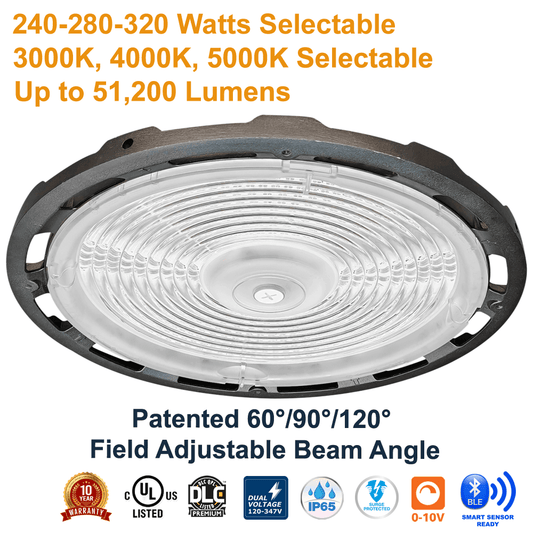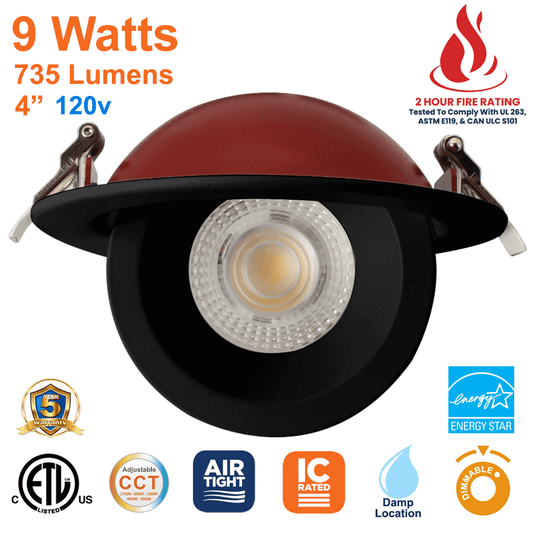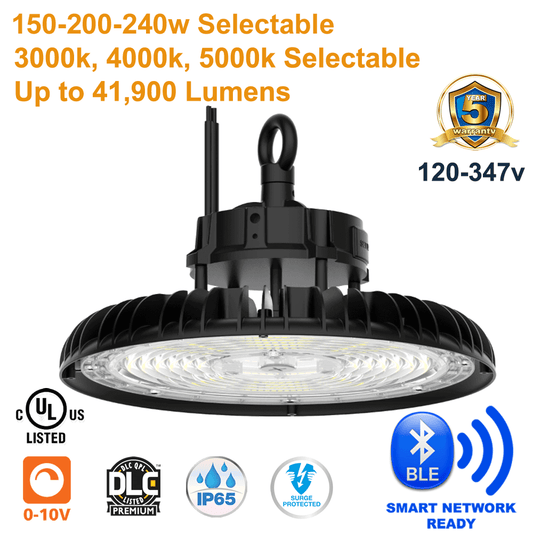Introduction:
LED Panel Lights have become the standard in dropped ceiling led lights as they deliver energy efficiency, long lifespan, and bright, uniform illumination. They have become widely adopted in multiple settings, such as offices, schools, hospitals, and homes.
There are two different types of LED Panel Lights; Edgelit LED Panels and Backlit LED Panels. In this article, we’ll review the differences between these two Panel Light options. But first, let’s take a look at what LED panel lights are.
What Is An LED Panel Light?
An LED Panel Light is a flat, light fixture designed to replace traditional fluorescent troffers and to fit into a suspended ceiling grid. Because of the traditional 2' x 4' and 2' x 2' grids of drop ceilings, the most common sizes are 2x4 LED Panels, 2x2 LED Panels, and 1x4 LED Panels. Surface mounting kits allow an LED Panel to be installed below a drywall ceiling, while a Flange Kit allows an LED Panel to be installed in an opening cut into a drywall ceiling.

Benefits Of LED Panel Lights:
LED Panel Lights have multiple benefits, when compared to traditional fluorescent lighting, such as:
- Energy Efficiency: LED panel lights consume less energy than fluorescent fixtures, which results in significant energy savings over time. They also emit less heat, which means lower air conditioning costs.
- Long Lifespan: LED panel lights have a much longer lifespan than traditional lighting. Today’s basic Light Panels have LED Chips projected to last up to 50,000 hours. Some of the LED Panel Lights we carry have LED Chip lifespan projected to beyond 100,000 hours.
- Elimination of Maintenance Costs: Because of the long lifespan of today’s LED Chips, and the improvements in heat dissipation, ballast and lamp replacements have become a thing of the past. For many commercial and industrial facilities this saves thousands of dollars annually.
- High Quality of Light: LED Panel Lights produce high-quality, uniform light that is flicker and glare free. This makes them an ideal choice for workspaces, classrooms, and other environments where visual comfort is important.
- Versatility: LED Panel Lights can be used in a wide range of applications, from general lighting in offices and schools to accent lighting in homes and retail spaces.
- Environmental Friendliness: LED Panel Lights are free from hazardous materials such as mercury, which is contained in all fluorescent tubes.
What Is The Difference Between An Edgelit Panel Light And A Backlit Panel Light?
Edgelit LED Panel Lights and Backlit LED Panel Lights are two types of Flat Panel LED Lights. The main difference between the two types of LED Panel Lights really comes down to the way they distribute light.
Edgelit Panel Lights have LEDs located around the edge of the panel. The light produced by the LEDs is diffused across the surface of the panel using a Light Guide Plate. The plate scatters the light and produces a uniform illumination across the panel.
Backlit Panel Lights, on the other hand, have LEDs located on the back of the panel. The light produced by the LEDs is directed towards the front of the panel, where it is diffused and produces a uniform illumination.
One of the biggest advantages of Edgelit Panel Lights is that they are thinner and lighter than Backlit Panel Lights, making them easier to install and more versatile in terms of where they can be used. Because of the placement of the LED chips, and the use of a Light Guide Plate, Edgelit Panel Lights also tend to have a wider beam angle, which means they can illuminate a larger area. This is beneficial in rooms with lower ceilings.
Backlit Panel Lights, on the other hand, tend to produce a more uniform illumination across the surface of the panel. This is because the light is directed towards the front of the panel, where it is diffused evenly. Backlit Panel Lights are also more efficient at producing colour-accurate light, so for applications where colour accuracy is important, such as in photography or graphic design, they are a good choice.
Backlit Panel Lights were the first type of LED Panel Light developed and introduced to the market. Initially, Backlit LED Panels were developed to replace traditional fluorescent troffers. Edgelit Panel Lights were brought to market later and became the more popular LED Panel Light choice because of their versatility their thinness and their lightness.

Overcoming Early Issues With Light Guide Plates:
Although Light Guide Plates are an essential component of Edgelit Panel Lights, there have been a few issues associated with their use in the past. However, manufacturers have come up with several solutions to these issues.
One of the most common early issues was that sometimes Light Guide Plates could cause light leakage. Light leakage occurred when a Light Guide Plate was not properly sealed, allowing light to escape from the edges of the panel. This resulted in uneven illumination and reduced overall brightness.
To address this issue, manufacturers began using a frameless design for their Light Panels. This design change eliminated the need for a frame around the panel, which reduced the risk of light leakage. Additionally, manufacturers began using a combination of adhesives and mechanical fasteners to ensure that the Light Guide Plate was properly sealed.
A second early issue with Light Guide Plates was that they sometimes produced a visible pattern on the surface of the panel. This was caused by the micro-structured layer of the Light Guide Plate. Some found the pattern distracting and felt it reduced the overall aesthetic appeal of the Panel Light.
To address this issue, manufacturers developed new micro-structured layers to produce a more uniform and subtle pattern. Additionally, manufacturers have started using thinner Light Guide Plates, which eliminated the visibility of the pattern.
Light Guide Plates were also vulnerable to damage, in the early days, if they were not handled carefully during installation. Scratches or cracks on the surface of the plate would lower the efficiency of an LED Panel Light, resulting in reduced brightness or uneven illumination.
To prevent this, manufacturers started using higher-quality materials for the Light Guide Plates. These materials are more resistant to scratches and cracks, ensuring that the Light Guide Plate would maintain its integrity during installation and efficiency over time.
One of the most commonly heard issues with early-generation Edgelit Panel Lights was the problem of yellowing. This occurred when the Light Guide Plate turned yellow over time, causing a shift in the colour temperature and a reduction in the brightness and overall performance of the Panel Light. The yellowing of the Light Guide Plate was caused when the acrylic or polycarbonate material of the Light Guide Plate degraded over time.
Faced with eliminating this issue, manufacturers developed new materials and coatings that are more resistant to yellowing. Some manufacturers now use a PMMA material that has a higher resistance to yellowing than traditional acrylic or polycarbonate or they use special coatings on the Light Guide Plate to prevent the material from degrading over time.
By introducing superior materials and implementing strict quality control measures to the Production of Light Guide Plates, the issue of yellowing is a thing of the past. Our Edgelit Panel Lights are guaranteed to never yellow.
In summary, while Light Guide Plates had some issues in the past, manufacturers have developed solutions to solve these problems. By using a frameless design, developing new micro-structured layers, and using higher quality materials, manufacturers have been able to produce Edgelit Panel Lights that maintain their colour accuracy, are aesthetically pleasing and are more durable.
Overcoming Early Issues With Backlit Panel Lights
Backlit Panel Lights also were not without their issues. Here are some of the most common issues of early-generation Backlit Panel Lights and what manufacturers have done to overcome them:
Despite being an LED technology, early Backlit Panel Lights faced a challenge from heat generation, which reduced the lifespan of the LEDs and other components.
To address this issue, manufacturers developed better heat dissipation technologies to improve the cooling performance of the LED Panel. This included the use of improved heat sinks and better thermal conductive materials.
Another issue with early Backlit Panel Lights was colour temperature inconsistency, which occurred due to shifts in the colour temperature of the LED Chips.
To overcome this issue, manufacturers continued to improve LED Chip technologies, which delivered more consistent and accurate colour temperature and CRI (Colour Rendering Index).
Early-generation Backlit Panel Lights could also be vulnerable to damage if they were not handled carefully during transportation and installation. Scratches or cracks on the surface of the LED Panel reduced the fixture’s efficiency and resulted in reduced brightness or uneven illumination.
To prevent this, manufacturers increasingly used higher quality materials, such as polycarbonates that are more resistant to scratches and cracks.
In summary, while Backlit Panel Lights faced their challenges in the early days of LED lighting, manufacturers introduced new and better materials, improved manufacturing processes, and quality control measures to overcome these issues.

LED Panel Light FAQs
Q: What is the lifespan of an LED panel light?
A: The LED Chips in base mode panel lights are projected to last up to 50,000. Some manufactures use higher quality LED Chips with projected lifespans far exceeding 100,000 hours. When an LED Chip has a longer lifespan, it maintains higher light output compared to LED Chips with shorter lifespans.
Q: Can LED panel lights be dimmed?
A: Yes, LED panel lights can be dimmed. Almost universally, LED Panel Lights use 0-10v dimming. This requires connecting low voltage wire from the LED Panel Light’s driver back to a compatible dimmer switch. Now, wireless Networked Lighting Controls allow you to dim and control an LED Panel Light without the time and expense of running wires.
Q: Can LED be used outdoors?
A: The majority of LED Panel Lights are generally not suitable for outdoor use. Simply put, they were not designed to withstand exposure to moisture and extreme temperature variations. Some manufacturers produce damp rated Panel Lights with a wide operating temperature range. These can be installed in covered areas, but a better solution is a Wet Rated Pot Light, or other fixture, built for exterior use.
Q: How do I install an LED panel light?
A: LED panel lights can be installed in a few simple steps. First, remove disconnect the electrical feed to the old lighting fixture, then remove the fixture. The new LED Panel Light is then moved into place and the wiring is connected to the driver box on the back of the LED Panel.
Summary:
In summary, the main difference between Edgelit Panel Lights and Backlit Panel Lights is the way the light is distributed. Edgelit Panel Lights have LEDs located around the edge of the panel, while Backlit Panel Lights have LEDs located on the back of the panel. Both types of LED Panel Lights have their own advantages and disadvantages, and the choice between them comes down to the specific requirements of each lighting application.
If you have any questions about your LED Panel Light options email us using our Contact Page, or call us at 1-800-979-4223.























